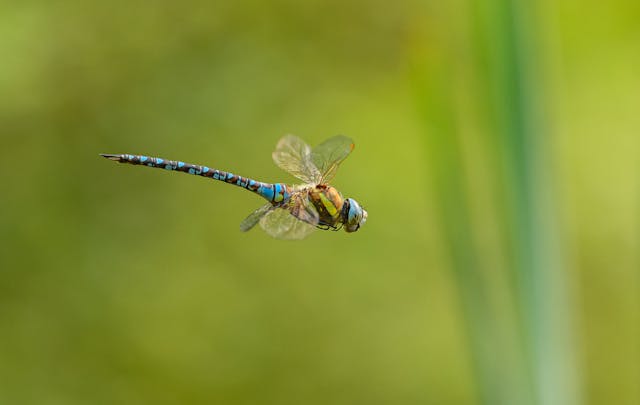
Why do some dragonflies migrate so far? Some species of dragonfly migrate a long way because of temperature and other triggers. How they do it is probably more interesting than why they do it.
There are two species of dragonfly that we are going to look at today. The first species is called the Green Darner and they migrate roughly 1,000 km from North America down towards Mexico. The second species is called the Pantala flavescens and it migrates about 18,000 km, with the 6,000 km across the Indian Ocean from Africa to India being done in one journey. We have looked at other insects that have incredibly long migrations as well. The Monarch butterfly is a very famous one.
Both of these dragonfly undertake a multi-generational migration. This is different to most species that migrate, birds for example, where one animal makes a yearly migration throughout its life. These dragonfly take a number of generations to make their journey. The Green Darner takes three generations to make its journey. The first generation are born in the south and migrate north during the spring and summer. The second generation are born in the north at the end of the summer and migrate south through the autumn. Then the third generation are born in the south in the winter and they don’t migrate. The fourth generation migrate and start the cycle again. The Pantala flavescens (also known as the globe wanderer) also takes several generations to make its trip. However, one single generation make the incredible flight between Africa and India. They do this by flying up into the trade winds and soaring with the wind. They are some of the highest flying insects and have been spotted at over 6,000 m.
It is interesting how scientists worked out that these dragonflies were multi-generational migratory dragonflies. The same dragonfly could be observed in many different areas, but that didn’t mean that it was migrating. You can often see the same insect in more than one place. Scientists worked out that it was a different generation because they analyzed the amount of hydrogen in its wings. They were able to get specimens from museums and they caught a lot of live dragonflies as well. They realized that the different samples had different types of hydrogen. Dragonflies lay their eggs in the stems of leaves or plants that are near to water. When the eggs hatch, the larvae drop into the water and they live there, getting larger, for the next couple of years. Because they grow in the water, the dragonfly larvae pick up hydrogen from the water and scientists realized that water in different places has different types of hydrogen. There is a heavy form of hydrogen called hydrogen-2 and it changes in quantity as you go from the north to the south in America. Scientists could analyze the quantity of this element in the dragonflies and see where they were born.
Scientists have been trying to figure out what triggers the dragonflies to migrate and they think it might be down to the temperature. There isn’t necessarily a difference between the generation that fly north, the generation that fly south, and the generation that don’t fly at all. The difference is in the environment and not in the insects themselves. The dragonflies that are in the south start to fly north when the temperature reaches 9℃. And the dragonflies that are in the north start to fly south when the temperature falls to 9℃. Presumably, the third generation don’t fly north or south because the temperature doesn’t hit 9℃. If there was a sudden drop in the temperature, the generation that don’t migrate might suddenly start to fly. Dragonflies have sensory cells in their wings and antennae which can detect temperature and humidity. These sensory cells in the wings can also detect strain, pressure, and air flow. Dragonflies use them to detect prey and to navigate.
Pantela flavescens have a multi-generational migration pattern as well, but the first part of their flight is carried out by one generation and is the longest single migratory flight of any insect. They fly up into the moist high-altitude trade winds. They have many adaptations to help them fly so far. They have bumps and protrusions on their wings that give them more lift and reduce drag. They also have larger wings than other dragonflies. Their wings are a slightly different shape, and they can be fixed in place, which means the dragonflies can glide without wasting energy. They are perfectly evolved to travel long distances. And this is what I learned today.
Try these:
Sources
https://en.wikipedia.org/wiki/Pantala_flavescens
https://en.wikipedia.org/wiki/Green_darner
https://northernwoodlands.org/outside_story/article/dragonfly-migration
https://british-dragonflies.org.uk/odonata/life-cycle-and-biology
https://royalsocietypublishing.org/doi/full/10.1098/rsbl.2018.0741
https://asknature.org/strategy/sensory-cells-give-dragonflies-smart-wings
Photo by Petr Ganaj: https://www.pexels.com/photo/close-up-of-flying-dragonfly-17989067/
